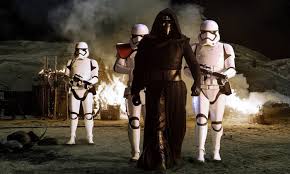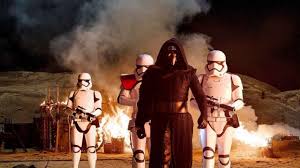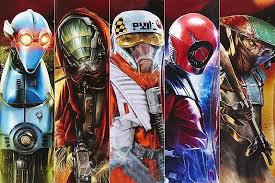Star Wars: The Force Awakens – A Cinematic Journey into a New Era
Introduction
Few films in cinematic history have carried the level of anticipation and cultural weight that Star Wars: The Force Awakens did upon its release in 2015. As the seventh installment in the legendary Star Wars saga, the movie marked the beginning of a new trilogy while also reconnecting audiences with beloved characters from the original films. Directed by J.J. Abrams and produced by Lucasfilm under the guidance of Kathleen Kennedy, this movie was not just another blockbuster—it was a global event.

The release of The Force Awakens represented more than just another entry in a popular franchise. It was a revival, a passing of the torch, and a reintroduction of Star Wars to a new generation. After Disney acquired Lucasfilm in 2012, fans wondered how the galaxy far, far away would evolve under new leadership. The Force Awakens answered that question by blending nostalgia with innovation, crafting a story that felt both familiar and refreshing.
The Background and Production
The creation of The Force Awakens began with the monumental purchase of Lucasfilm by Disney in 2012 for over $4 billion. Along with the deal came the rights to one of the most iconic franchises in entertainment history. Disney wasted no time announcing a new trilogy of Star Wars films that would continue the story after Return of the Jedi (1983).

J.J. Abrams, known for revitalizing the Star Trek franchise and for his work on television series like Lost, was brought on as director. His mission was clear yet challenging: honor the legacy of Star Wars while pushing it into uncharted territory. Abrams, along with co-writer Lawrence Kasdan—who had previously co-written The Empire Strikes Back and Return of the Jedi—crafted a script that balanced fan service with new ideas.
The film was primarily shot at Pinewood Studios in the United Kingdom, with on-location shoots in Abu Dhabi, Iceland, and Ireland, which provided authentic landscapes for the desert planet Jakku and other galactic settings. One of the most important aspects of production was the decision to use practical effects alongside digital ones. This approach paid homage to the original trilogy, which was famous for groundbreaking model work and physical set designs.
With John Williams returning to compose the score, practical effects teams building full-scale sets, and a mix of new and returning cast members, the production of The Force Awakens was designed to deliver both spectacle and authenticity.

Story Overview
The narrative of The Force Awakens takes place approximately 30 years after the events of Return of the Jedi. The galaxy is still in conflict, with the remnants of the Galactic Empire reorganized into a militaristic faction called the First Order. In response, the Resistance, backed by the New Republic, seeks to defend freedom and restore balance.
At the heart of the story are new characters: Rey, a scavenger living on the desert planet Jakku; Finn, a stormtrooper who defects from the First Order; Poe Dameron, a skilled Resistance pilot; and Kylo Ren, a dark warrior devoted to the legacy of Darth Vader. These characters form the backbone of a new generation of heroes and villains, while familiar faces like Han Solo, Leia Organa, and Chewbacca return to guide them.
The plot follows the search for Luke Skywalker, the last known Jedi, who has vanished. Both the Resistance and the First Order seek him, knowing that his presence could shift the balance of power in the galaxy. What unfolds is a thrilling adventure filled with action, emotion, and revelations that set the stage for the new trilogy.
Themes and Symbolism
Like its predecessors, The Force Awakens is more than just a science fiction spectacle; it is a story rich in themes that resonate deeply with audiences.
The Hero’s Journey Reimagined
Rey embodies the classic archetype of the reluctant hero. Her journey from scavenger to central figure in the galaxy mirrors the paths of Luke Skywalker and other mythological heroes, yet her story feels unique and empowering.

The Battle Between Light and Dark
Kylo Ren’s inner conflict is one of the central themes of the movie. His struggle with identity, legacy, and morality reflects the eternal Star Wars theme of the balance between good and evil.
Legacy and Renewal
The film explores the idea of generational change. Beloved characters from the past pass their knowledge, wisdom, and responsibilities to new heroes. This theme resonates with the audience, as it reflects the way stories and traditions are passed down in real life.
Identity and Belonging
Both Rey and Finn grapple with questions of who they are and where they belong in the galaxy. These personal struggles echo broader questions of destiny and choice that run throughout the saga.
Characters and Performances
Rey – Played by Daisy Ridley
Rey quickly became a fan-favorite, bringing strength, vulnerability, and curiosity to the role. Daisy Ridley, a relative newcomer at the time, carried the film with her charismatic and emotionally grounded performance.

Finn – Played by John Boyega
As a stormtrooper who breaks free from the First Order, Finn represents hope and courage. Boyega’s portrayal of Finn added humor and humanity to the film.
Kylo Ren – Played by Adam Driver
Kylo Ren’s character stands as one of the most complex figures in the Star Wars universe. Adam Driver’s intense performance captured the conflict of a villain torn between the dark side and lingering ties to the light.
Poe Dameron – Played by Oscar Isaac
Poe, the Resistance pilot, brought charm and bravery to the screen. Isaac’s natural charisma elevated Poe from a supporting role to a fan-favorite.
Han Solo – Played by Harrison Ford
The return of Han Solo was a highlight of the film. Ford slipped back into the role effortlessly, bringing humor, heart, and gravitas to his character’s arc.
Leia Organa – Played by Carrie Fisher
Carrie Fisher’s return as General Leia Organa provided the film with emotional depth and a sense of continuity. Her leadership and strength were inspiring both on and off screen.

Direction and Cinematography
J.J. Abrams approached The Force Awakens with a sense of reverence for the original trilogy. His direction balanced fast-paced action with emotional storytelling. Abrams was particularly praised for his use of practical effects, ensuring that the film felt grounded despite its large-scale spectacle.
The cinematography, led by Dan Mindel, blended sweeping desert landscapes, gritty interiors, and epic space battles. The visual style evoked the original films while embracing modern technology.
Music and Sound
John Williams returned to compose the score, continuing his decades-long association with Star Wars. While introducing new themes such as “Rey’s Theme” and “March of the Resistance,” he also reworked iconic motifs from the original films. The result was a soundtrack that felt both nostalgic and fresh, underscoring the emotional core of the story.
The sound design, created by Skywalker Sound, played a vital role in immersing audiences. From the hum of lightsabers to the roar of TIE fighters, every sound was meticulously crafted.
Box Office Performance
Upon release in December 2015, The Force Awakens shattered box office records. It grossed over $2 billion worldwide, becoming the highest-grossing film of all time in North America at the time. Its success proved that Star Wars was still a dominant cultural force, capable of uniting generations of fans.

Critical Reception
Critics praised the film for recapturing the magic of the original trilogy while introducing compelling new characters. The performances, particularly those of Daisy Ridley and Adam Driver, were widely applauded. Some critics noted the film’s similarities to A New Hope, but most agreed that its balance of nostalgia and new energy made it a triumph.
Cultural Impact
The Force Awakens reignited Star Wars fandom across the globe. Merchandise sales skyrocketed, cosplay communities flourished, and discussions about the film dominated pop culture. For younger audiences, it became an entry point into the saga, while older fans celebrated the return of familiar heroes.
The movie also sparked conversations about diversity and representation, with Rey, Finn, and Poe reflecting a broader spectrum of characters than seen in earlier films.
Legacy
As the first installment of the sequel trilogy, The Force Awakens laid the foundation for The Last Jedi and The Rise of Skywalker. It reminded audiences why Star Wars was such a powerful cultural phenomenon while ensuring its relevance for future generations.
Despite debates among fans about the direction of the sequel trilogy as a whole, The Force Awakens remains a beloved chapter in the saga. It demonstrated how a film could honor its past while charting a course for the future.

Conclusion
Star Wars: The Force Awakens is more than just a film—it is a cultural milestone. By blending nostalgic elements with bold new storytelling, it successfully revived one of the most iconic franchises in history. Its memorable characters, epic visuals, stirring score, and timeless themes ensure that it will be remembered for decades to come.
For long-time fans, it was a chance to relive the excitement of the original trilogy. For newcomers, it was an invitation into a galaxy of imagination and wonder. Above all, The Force Awakens proved that the Force would continue to inspire, connect, and thrill audiences across the world.
FAQs:
1. What is Star Wars: The Force Awakens about?
The film takes place 30 years after Return of the Jedi. The galaxy faces a new threat from the First Order, while the Resistance searches for the missing Luke Skywalker. New heroes like Rey, Finn, and Poe join forces with iconic characters such as Han Solo and Leia Organa.
2. Who directed Star Wars: The Force Awakens?
The movie was directed by J.J. Abrams, who is also known for Star Trek (2009) and the TV series Lost.
3. When was the movie released?
The Force Awakens premiered in December 2015 worldwide, becoming one of the biggest box office successes of all time.
4. Who are the main characters in the film?
Key characters include Rey (Daisy Ridley), Finn (John Boyega), Kylo Ren (Adam Driver), Poe Dameron (Oscar Isaac), Han Solo (Harrison Ford), and Leia Organa (Carrie Fisher).
5. Is The Force Awakens part of the original Star Wars trilogy?
No. It is the seventh episode in the saga and the first film in the sequel trilogy, continuing the story after the original trilogy.
6. How much did The Force Awakens earn at the box office?
The movie grossed over $2 billion worldwide, making it one of the highest-grossing films in history.
7. Did The Force Awakens receive positive reviews?
Yes. Critics and fans praised its nostalgic feel, new characters, strong performances, and visual effects. Some noted its similarities to A New Hope, but overall reception was highly positive.
8. Who composed the music for The Force Awakens?
The legendary John Williams returned to score the film, introducing new themes like “Rey’s Theme” while revisiting classic motifs.
9. Where was the movie filmed?
The film was shot at Pinewood Studios in the UK, with additional locations in Abu Dhabi, Iceland, and Ireland.
10. Why is The Force Awakens important in the Star Wars saga?
It reintroduced Star Wars to a new generation, blended classic characters with fresh heroes, and launched the sequel trilogy, ensuring the franchise’s continued legacy.
